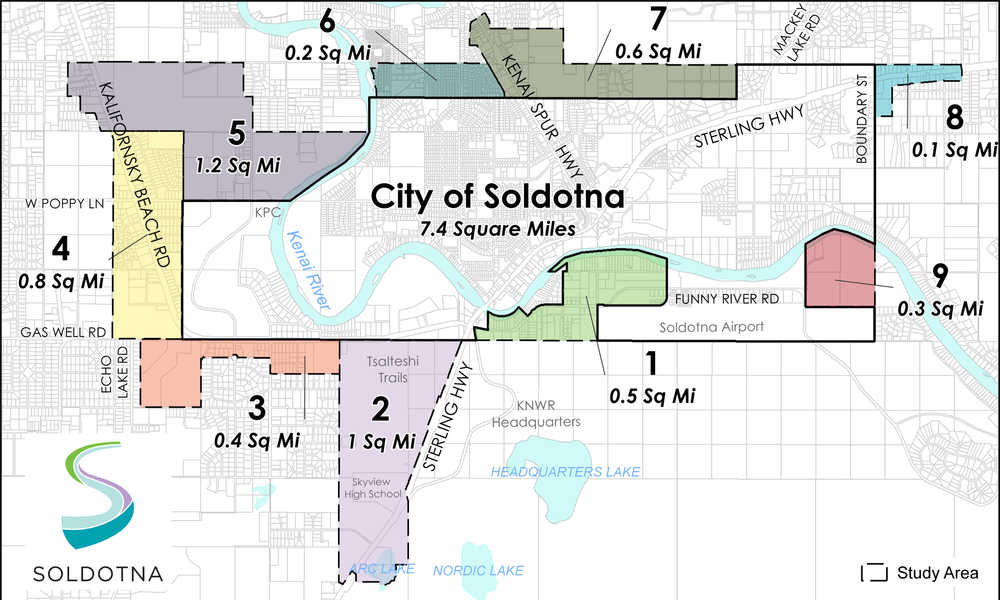Soldotna staff and council members have a big decision to make — whether to pursue annexing nearby neighborhoods to make them part of the city — and they will seek the public’s input.
The city hired Anchorage-based consulting group Northern Economics to analyze the fiscal effects annexation would have on Soldotna. Work began about a year ago and final report was done June 9, said Johnathan King, Northern Economic’s vice president and senior economist who presented the findings at a work session before the Soldotna City Council’s Wednesday meeting. The study is available on the city’s website, and Director of Economic Development and Planning Stephanie Queen said city staff can print out a hard copy for people who request it free of charge.
Now that council members and administration staff have been briefed on what it would mean financially for the city to annex certain areas, it is up to the city to decide whether to draft a petition and submit it to the Local Boundary Commission, which has the ultimate authority to allow communities to annex, King said.
“There’s actually nothing in the study that would require you to go forward with annexation, to use the areas that we analyzed, to not use the areas that we analyzed,” King told council members. “Really, as you move forward the world is your oyster, and the purpose of the study is … really to give you that picture of the areas that we think might be likely candidates for annexation, or not for annexation.”
The study analyzed nine geographic areas outside Soldotna to see how their annexation would impact the city financially. They were identified as Funny River West, Skyview, K-Beach South, K-Beach Central, K-Beach North, Knight Drive, Kenai Spur, Sterling Highway and Funny River. King and Shanna Zuspan of consulting group Agnew Beck, who also presented to the council, said analysts worked closely with city staff to narrow down their analysis to those nine geographic areas using factors like prior city comprehensive plans, prior work done by an annexation working group and Local Boundary Commission guidelines.
“It was important to look at areas that were already receiving city services or could receive them more efficiently,” Zuspan said. “A big part was looking at areas where commercial highway corridors or nodes are near the city … underdeveloped areas which could benefit from city services and any areas that could address health and safety issues.”
The Knight Drive study area, just north of Soldotna, was identified in the analysis as highly residential with limitations for future development, making it a financially negative area to annex. Revenue generated through the Knight Drive area would only cover about 40 percent of the costs to provide services to it, according to the study.
Other areas, like the Kenai Spur section which is also north of the city and includes a significant commercial property base, would have a positive fiscal effect on Soldotna, according to the study. The analysis found the Kenai Spur area would generate about $430,000 annually, as of 2015, if it were to be annexed. When the annual revenue effects for all nine areas were combined in the study, it was found Soldotna would gain about $350,000 a year if it chose to annex every single area.
Zuspan said that even though economic study focuses only on the economics of potential annexation, there are several other components to petitions submitted to the Local Boundary Commission that it uses when determining if an area is appropriate for annexation. These include a need for city government, whether the territory is compatible, if the population is large enough, if the boundaries are appropriate and whether the annexation would be in the best interest of the state.
“The resources of the proposed territory, that’s the one where the LBC will be looking to make sure that annexing territories have adequate financial resources they bring with them to ensure that essential city services are provided in a cost effective way,” Zuspan said.
Residents and commercial property owners attended the council’s work session. Patricia Patterson, who owns commercial property within the Kenai Spur study area but does not live there, said she feels the discussion is too focused on the economics of annexation and not enough on other factors.
“I would like to see the direction of annexation be more about the community that they are creating and less about how much money they’re going to be making,” Patterson said. “I just would love to see the direction be about how are they going to bring me into the community as a commercial business, bring me in as an active community member instead of how much money I can bring them.”
King and Zuspan said the Local Boundary Commission requires communities pursuing annexation to hold at least one public meeting, but suggests far more community involvement. The city will host a public open house to present and discuss the economic study’s findings from 4-7 p.m. June 30 at the River Center in Soldotna.
Reach Megan Pacer at megan.pacer@peninsulaclarion.com.

